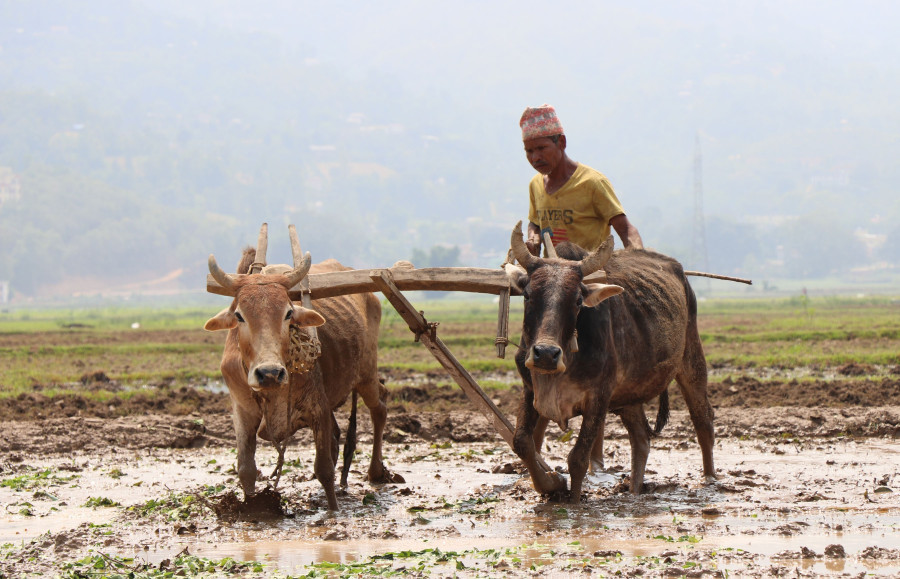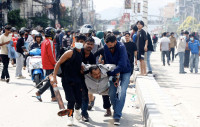Columns
Equitable, resilient and sustainable food system
Nepal has no choice but to increase its agricultural production by enhancing land and irrigation water productivity.
Khem Raj Sharma
The National Planning Commission is in the process of finalising pathways to transform Nepal towards “an equitable, resilient and sustainable food system” in collaboration with the UN, development partners, private sector and other key stakeholders. A series of dialogues has been convened to examine the existing food systems in terms of expectations, functioning, vulnerabilities and opportunities. The final dialogue was organised in Kathmandu recently. This exercise in Nepal is being carried out in line with the UN Food System Summit 2021 which was organised to establish the future direction for sustainable food systems and accelerate collective action in the world, which eventually is expected to be instrumental for achieving the UN Sustainable Development Goals (SDGs), one of which is to end hunger, achieve food security, improve nutrition and promote agricultural sustainability worldwide by 2030.
As reported in the Kathmandu dialogue, the contribution of the farm sector to Nepal's GDP has fallen to 24 percent. Agriculture employs about 67 percent of the total population, 70 percent of whom are women. Of the country's total geographical area, only 28 percent is agricultural land and only 21 percent of it is under cultivation. The current level of land holding is 0.68 hectare, and 53 percent of the farmers fall under the category of smallholders with less than 0.5 hectare. Nepal’s Global Hunger Index in 2021 was 19.1 percent, and the country was ranked 73rd globally. In the last fiscal year (2021-22), Nepal’s total import of goods and services amounted to Rs1.920 trillion of which the share of agricultural goods was 19.71 percent. The trade gap is widening as the country’s exports in the same year were worth only Rs200 billion.
All these figures indicate that we are a food deficit country, and to meet our national food demands, the focus should first be on ensuring agricultural growth. The country has adopted the Green, Resilient and Inclusive Development (GRID) approach to ensure inclusive and sustainable growth. It will be timely to review whether the planned pathways and actions are in line with the GRID approach.
The problem areas
Environmental, demographic, technological, socio-economic, physical and cultural are identified as the key drivers affecting food system transformation and sustainability. Climate change, urbanisation, conversion of agricultural land for non-agricultural purposes, land fragmentation, lack of appropriate technology, out-migration, inadequate physical infrastructure, unhealthy food traditions, and low water and land productivity are some of the factors under these major drivers. Soil fertility in Nepal, with the reduced percentage of organic matter content to around 1 percent, is decreasing against the requirement of at least 3 percent.
Climate disaster is a new normal now. The Chure range and the forest area are rapidly degrading, adversely affecting the vast fertile land in the Tarai. One estimate suggests that about 240 million cubic metres of our topsoil is being lost annually. Rich forests in general help conserve soil and water. Prices of basic food items like rice, wheat flour, vegetables, fruits and cooking oil have increased sharply.
Given the scenario, the country’s food production and demand outlook should be reviewed. The present population of about 30 million is expected to increase to 42 million by 2040. Demand for water for drinking, agriculture, industry, power generation and other uses will continue to increase. One simple estimate suggests that to ensure food sufficiency in the country, a two-fold increase in food production will be required by the year 2040.
On the global scale, 70 percent of the freshwater is used for agriculture, 20 percent for industry and 10 percent for domestic purposes. In Nepal, domestic and industrial water uses account for a minimal percentage, and over 90 percent of the total water is used for irrigated agriculture. The increased demand for water for different sectors will have to be met by proper planning, and the lion's share presently used by irrigation will have to be reduced to a level as low as the global average. As a remedial measure, we should increase the efficiency of irrigation water use by modernising the existing irrigation schemes, promoting micro-irrigation technology, strengthening essential agricultural support services, empowering women and the poor and adapting to the integrated use of land, water and forest resources. Livestock rearing and fishery are two other components to be promoted.
Technology development, which also includes information dissemination, to help farmers adopt improved farm technologies and apply new techniques in the management of soil, water and natural vegetation along with the use of fertilisers, hybrid/high yielding seeds, and pest management needs to be developed. Timely weather forecasting will help farmers to plan for farm operations. Agricultural research pertaining to crop varieties, input use, plant protection and livestock management including poultry birds, farm power and mechanisation are some of the areas to be focused on. Research on irrigation and farm water management is practically non-existent. The same is true for crop intensification, diversification of farming systems and marketing mechanisms. Universities need to join hands with the government and private sector in planning and executing research agendas. Policy research should be more participatory.
Good governance
Nepal has no choice but to increase its agricultural production by enhancing land and irrigation water productivity. All weather roads connecting farms to market are of high importance so that farmers can sell their products directly without the involvement of middle persons. Emphasis needs to be laid on cost-effective and simple small-scale facilities and infrastructure that are easy to construct within a short timeframe and can be managed at the local community level.
On top of all, we need to develop skills for good governance to ensure an efficient, effective, transparent and accountable state apparatus that allows participation of the private sector including international organisations and non-governmental organisations. In view of the presence of a big percentage of smallholders, agricultural development based on improvements in the productivity of small farms ought to be emphasised. Easy access to agricultural credit is another area deserving special focus.




 7.12°C Kathmandu
7.12°C Kathmandu















